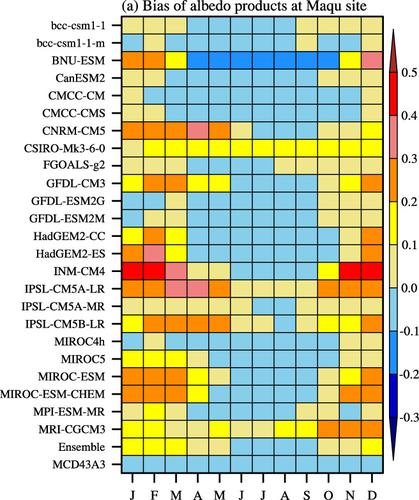当前位置:
X-MOL 学术
›
Int. J. Climatol.
›
论文详情
Our official English website, www.x-mol.net, welcomes your
feedback! (Note: you will need to create a separate account there.)
Evaluation of surface albedo over the Tibetan Plateau simulated by CMIP5 models using in-situ measurements and MODIS
International Journal of Climatology ( IF 3.5 ) Pub Date : 2021-07-01 , DOI: 10.1002/joc.7281 Yingying An 1, 2, 3 , Xianhong Meng 1, 2 , Lin Zhao 1, 2 , Zhaoguo Li 1, 2 , Shaoying Wang 1, 2 , Lunyu Shang 1, 2 , Hao Chen 1, 2 , Shihua Lyu 4, 5
International Journal of Climatology ( IF 3.5 ) Pub Date : 2021-07-01 , DOI: 10.1002/joc.7281 Yingying An 1, 2, 3 , Xianhong Meng 1, 2 , Lin Zhao 1, 2 , Zhaoguo Li 1, 2 , Shaoying Wang 1, 2 , Lunyu Shang 1, 2 , Hao Chen 1, 2 , Shihua Lyu 4, 5
Affiliation

|
Surface albedo plays a key role in the energy and water cycles, and reasonable parameterizations of surface albedo will be greatly helpful to improve the simulation of radiation partition in climate models. In-situ measurements of albedo from five sites over the Tibetan Plateau (TP) and MODIS albedo product are used to evaluate monthly, annual, and seasonal variations of the surface albedo simulated by 24 Global Climate Models (GCMs) archived by the Coupled Model Intercomparison Project Phase 5 (CMIP5). Potential factors contributing to the bias of simulated albedo were investigated. The results show that the monthly albedo of 24 GCMs varied across models, and the difference among the models was smaller in the June–July–August period than the December–January–February period. The ensemble mean albedo of the 24 GCMs was more consistent with the in-situ measurements than the individual model. The albedo calculated from the BNU-ESM, GFDL-CM3, INM-CM4, MIROC4h, MIROC-ESM, and MIROC-ESM-CHEM models coincided with the observations from June to September, increasing rapidly to above 0.4 from November. However, the annual cycle of surface albedo was insignificant when simulated by some models, such as CanESM2, CSIRO-Mk3.6.0, CMCC-CMS, IPSL-CM5A-MR, and MPI-ESM-MR. Additionally, the surface albedo was overestimated by CMIP5 multi-model ensemble mean—with a smaller amplitude of daily albedo—compared with the values estimated from in-situ observations and MCD43A3. In all 24 models, snow albedo parameterization schemes were found to variably fit the attenuation of snow albedo over time. The cold temperature, relatively more precipitation, fresh snow density, and albedo in these models led to large biases in snow depth and ablation. The surface albedo tends to increase without the influence of blowing snow and withered grass on the model's albedo.
中文翻译:

利用原位测量和 MODIS CMIP5 模型模拟青藏高原地表反照率评估
地表反照率在能量和水循环中起着关键作用,合理的地表反照率参数化将有助于改进气候模型中辐射分区的模拟。青藏高原 (TP) 上五个地点的反照率原位测量值和 MODIS 反照率产品用于评估耦合模式比对存档的 24 个全球气候模型 (GCM) 模拟的地表反照率的月度、年度和季节变化项目第 5 阶段 (CMIP5)。研究了导致模拟反照率偏差的潜在因素。结果表明,24个GCM的月反照率因模型而异,6-7-8月的模型间差异小于12-1-2月的差异。24 个 GCM 的整体平均反照率比单个模型更符合原位测量。从 BNU-ESM、GFDL-CM3、INM-CM4、MIROC4h、MIROC-ESM 和 MIROC-ESM-CHEM 模型计算的反照率与 6 月至 9 月的观测结果一致,从 11 月迅速增加到 0.4 以上。然而,在CanESM2、CSIRO-Mk3.6.0、CMCC-CMS、IPSL-CM5A-MR和MPI-ESM-MR等模型模拟时,地表反照率的年周期并不显着。此外,与现场观测和 MCD43A3 估计的值相比,CMIP5 多模式集合平均值(每日反照率幅度较小)高估了地表反照率。在所有 24 个模型中,发现雪反照率参数化方案可以随时间变化地拟合雪反照率的衰减。寒冷的温度,这些模型中相对较多的降水、新雪密度和反照率导致雪深和消融存在较大偏差。在不受吹雪和枯草对模型反照率影响的情况下,地表反照率趋于增加。
更新日期:2021-07-01
中文翻译:

利用原位测量和 MODIS CMIP5 模型模拟青藏高原地表反照率评估
地表反照率在能量和水循环中起着关键作用,合理的地表反照率参数化将有助于改进气候模型中辐射分区的模拟。青藏高原 (TP) 上五个地点的反照率原位测量值和 MODIS 反照率产品用于评估耦合模式比对存档的 24 个全球气候模型 (GCM) 模拟的地表反照率的月度、年度和季节变化项目第 5 阶段 (CMIP5)。研究了导致模拟反照率偏差的潜在因素。结果表明,24个GCM的月反照率因模型而异,6-7-8月的模型间差异小于12-1-2月的差异。24 个 GCM 的整体平均反照率比单个模型更符合原位测量。从 BNU-ESM、GFDL-CM3、INM-CM4、MIROC4h、MIROC-ESM 和 MIROC-ESM-CHEM 模型计算的反照率与 6 月至 9 月的观测结果一致,从 11 月迅速增加到 0.4 以上。然而,在CanESM2、CSIRO-Mk3.6.0、CMCC-CMS、IPSL-CM5A-MR和MPI-ESM-MR等模型模拟时,地表反照率的年周期并不显着。此外,与现场观测和 MCD43A3 估计的值相比,CMIP5 多模式集合平均值(每日反照率幅度较小)高估了地表反照率。在所有 24 个模型中,发现雪反照率参数化方案可以随时间变化地拟合雪反照率的衰减。寒冷的温度,这些模型中相对较多的降水、新雪密度和反照率导致雪深和消融存在较大偏差。在不受吹雪和枯草对模型反照率影响的情况下,地表反照率趋于增加。











































 京公网安备 11010802027423号
京公网安备 11010802027423号